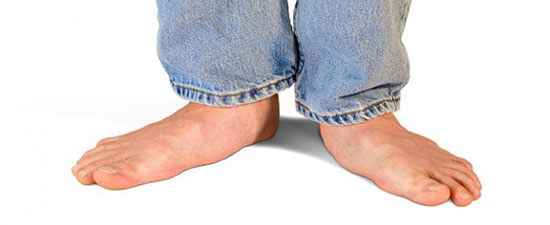Look at the feet of a baby. We all begin life with tiny little Barney Rubble feet. Unfortunately, some of us revert to that condition as time and/or trauma affect our feet and make walking difficult.
What is adult acquired flatfoot deformity?
The feet of infants and toddlers start off flat as a board with no discernible bend in the foot. As our feet grow, we begin to develop a pronounced arch. As we get older and our feet absorb accidental trauma or repetitive impacts, the arch tends to fall. With adult acquired flatfoot deformity, the entire sole touches the floor when we are standing.
Complications of adult acquired flatfoot

Sometimes adult acquired flatfoot deformity (AAFD) causes no negative symptoms. In such cases, of course, no treatment is needed. However, AAFD can cause problems in our ankles and knees because with no arch in our feet, the alignment of our legs is often impacted. Lack of a flexible arch can diminish our mobility and impair our balance. Patients with AAFD are often concerned with how it interferes with daily activities.
AAFD is often the cause of painful problems in the feet, particularly in the heel and the arch itself. Pain and associated swelling usually get worse with any significant increase in physical activity, even just walking.
Conservative treatment options for AFFD
When problems caused by AAFD are serious and mobility is becoming a challenge, it’s time to seek help from a podiatric physician. It’s generally advisable to begin treatment with the most conservative and least invasive remedial methods. Such treatments include rest and immobilization, shoe inserts, braces, and physical therapy.
When AAFD isn’t responsive to conservative therapy, consider surgical remedies
The two most common AAFD surgical modalities are reconstruction and fusion. Reconstructive surgery is generally preferable. It helps keep flexibility in the foot allowing a return to physical activity. However, reconstruction is more complicated than fusion. It has a longer recovery period, and there has been greater risk of surgical failure. Fusion is simpler, more reliable, with less of a recovery ordeal. Unfortunately, the results from fusion surgery include a significant loss of flexibility that affects walking and repeated physical activity.
Advanced techniques and hardware now make reconstructive surgery the best option
In the past, reconstructive surgeries were considered for younger patients only. Fusion surgery was prescribed for older patients. The presumption was that older patients aren’t as physically active as they once were, and therefore require less flexibility in their surgical outcomes. However, this no longer holds true because older patients are often maintaining their physical activity and health. Additionally, as podiatric surgeons become more skilled in advanced surgical techniques, and as new surgical hardware is introduced, reconstructive surgery has moved to the forefront of surgical options for flat feet.
Now a recent study shows that reconstruction surgery for seniors is a better option. It helps preserve flexibility in their feet and enable increased post-surgical activity. Researchers studied 130 patients who had undergone reconstructive surgery. The patients were divided into three groups: under 45 years old (young); 45 to 65 (middle) and over 65 (older).
The results of the study were presented at the March 10 annual meeting of the American Academy of Orthopedic Surgeons. Two years after surgery, the older patients didn’t show any differences in their surgical outcomes, as compared with those patients in the young and middle groups. The older patients were also no more likely to undergo post-surgical revisions, or removal of surgical hardware, then were the younger patients.
Flatfoot reconstruction is a great option for patients of any age
“Our initial hypothesis was that there would be increased complications for patients in the older group. However, we saw positive, consistent surgical outcomes across all age groups,” said Dr. Scott J. Ellis, the lead author of the study. “Depending on the severity of the condition, we believe that flatfoot reconstruction is a great option for patients regardless of their age. For the right patient, it can be the last surgery that they need.”
The physicians at University Foot and Ankle Institute are nationally recognized as experts in the surgical treatment of flat feet in both adults and children.
Our surgeons continue to help develop many orthopedic products and surgical procedures that are used in flat feet corrective surgery. According to UFAI’s Dr. Bob Baravarian, “We perform these surgeries with a high level of success. It’s important to address the full foot and correct all underlying issues without cutting corners for an ideal outcome.”
If your feet are flat and causing you any significant problems, please don’t hesitate to schedule an appointment with UFAI. Our extremely well-trained surgeons are at the cutting edge of flatfoot reconstructive surgery, and we can relieve your pain while we help you regain your old flexibility, mobility, and balance.
For more information or to schedule a consultation, please call (877) 736-6001 or visit us at www.footankleinstitute.com.
- The Power of Pediatric Flexible Flatfoot Procedures - September 21, 2023
- StimRouter: A Revolutionary Approach to Targeted Pain Relief - August 21, 2023
- Is Cosmetic Foot Surgery Safe? Or Are You Starting Off on the Wrong Foot? - May 17, 2023

Leave a Reply